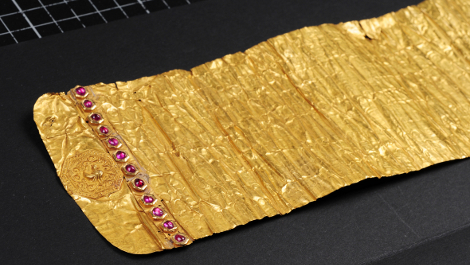On 7 May 1756, King Alaungphaya of Myanmar ordered a letter to be written to the British King (and Hanoverian Elector) George II proposing the establishment of a trading colony in his territory. Alaungphaya was the founder of the Konbaung dynasty, which ruled in Myanmar until 1886. Following a long period of war and division, he united the country, returning it to a position of power in the region.
The letter is engraved on a sheet of pure gold measuring 55 x 12 cm and is adorned with 24 precious rubies. It was contained in the hollow tusk of an Indian elephant. The materials used in and the care taken with its production are a visible demonstration of the importance the author of the letter attached to it.

Alaungphaya’s offer was of global significance, as it could have helped Britain in her colonial competition with France. However, after a two year journey to London, the letter was never answered. King George II, tied up with the wars in Europe, sent it home to his library in Hanover. As a result of his offer falling on deaf ears, Alaungphaya had Britain’s only trade settlement in his country destroyed, and relations between the two countries were broken off for centuries.
For 250 years the original letter was believed lost. Although the Golden Letter had always been regarded as a particularly valuable document in the library, little was known of its importance in world history. In 2007, Jacques Leider, carrying out research on behalf of the Gottfried Wilhelm Leibniz Library, shed light on the matter. The first public displays of the Golden Letter in Hanover in 2011 attracted tens of thousands of visitors and sparked global media interest.

On behalf of the Federal Foreign Office and with support from the Gottfried Wilhelm Leibniz Library, the company Scanbull Software GmbH digitised the Golden Letter in 3D so that with the available data it can be presented in various ways: 3D projections of the digital model in mid air, on a screen, in glass showcases or as facsimiles or print-outs. The valuable data enable the model to be presented in virtually every analogue and digital format, allowing it to be reproduced in freely selected media – from a print-out of a particular detail to a media installation. On the basis of this digitised version, the Government of Myanmar is being provided with a 3D film of the Golden Letter and a 3D monitor for the exhibit in the new national museum in Nay Pyi Taw.
Project: Dr. Georg Ruppelt, Director of the Gottfried Wilhelm Leibniz Library
Promoted by: Cultural Preservation Programme of The Federal Foreign Office

